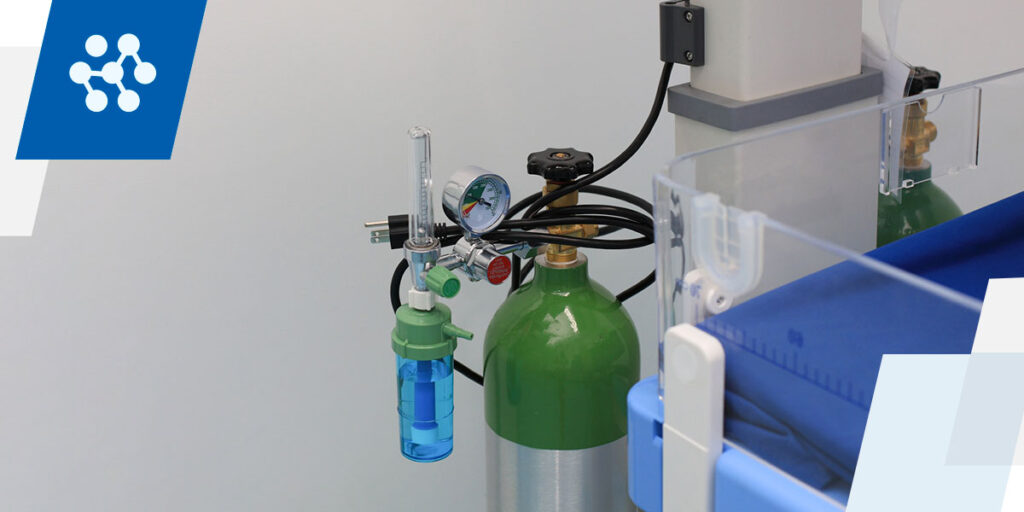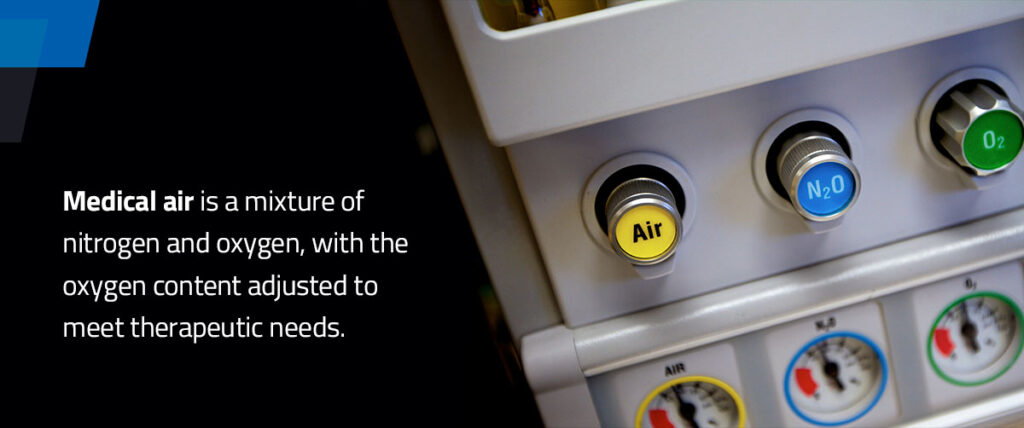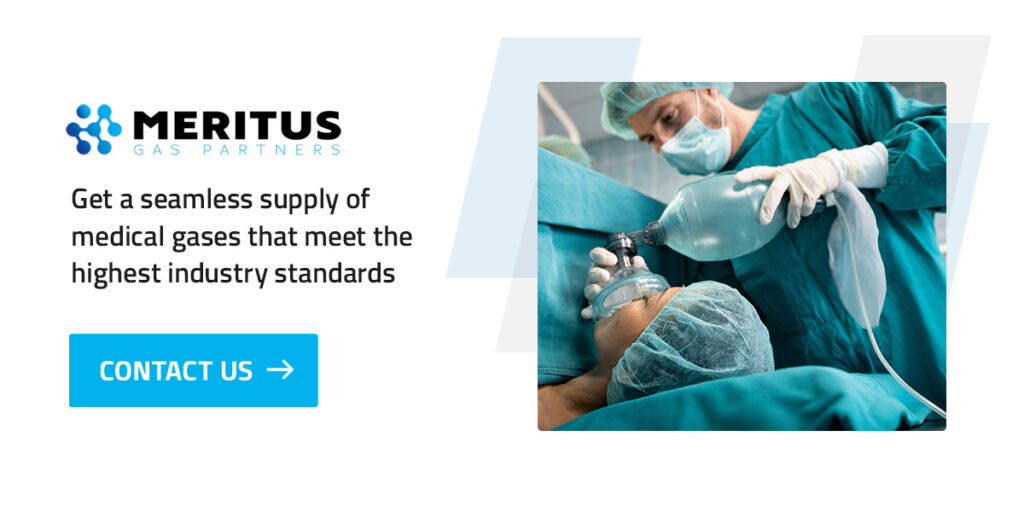

Medical gases are indispensable in healthcare. There are numerous uses for medical gases, especially for respiratory support, anesthesia and diagnostic procedures. Healthcare professionals and facility owners must understand the properties of these medical gases, their administration methods and safety considerations to help protect patients, providers and hospitals.
What are the different types of gases used in hospitals and other healthcare facilities? This article will be your comprehensive guide on the fundamental concepts of medical gases. From the life-sustaining properties of oxygen to the analgesic effects of nitrous oxide, each gas contributes to patient care — in one way, shape or form.
Let’s explore the seven commonly used gases in healthcare, their unique applications and safety considerations.
Oxygen has numerous life-saving applications in healthcare. It’s crucial in various healthcare settings, including hospitals, emergency rooms and ambulances.
Oxygen is a vital medical gas for patients with respiratory insufficiency or hypoxia. Air and oxygen in medical gas systems also help keep patients alive during surgeries and after major traumas. Additionally, oxygen therapy is used to help improve oxygen levels in the blood and alleviate breathing difficulties.
Medical oxygen can be delivered through a nasal cannula, face masks or ventilators. The delivery method depends on the patient’s condition and the required oxygen concentration. For example, nasal cannulas are commonly used for low-flow oxygen, while masks are suitable for higher concentrations.
While oxygen is essential for life, it should be handled with care. Measures should be taken to prevent combustion, as oxygen supports combustion and can enhance the intensity of fires. Facilities must follow strict safety protocols for storing, handling and administering medical oxygen.
Moreover, the key to medical-grade oxygen is high purity. If it’s contaminated with other gases, it may pose risks to patients. Healthcare facilities must partner with a supplier that can provide high-purity oxygen for their patient’s well-being.
Nitrogen, a colorless and odorless gas, has various applications in healthcare settings. While it is not typically used on patients, it has multiple uses for medical equipment and support processes.
For instance, nitrogen is commonly used to power pneumatic systems in medical devices. Think of surgical tools and equipment used in diagnostic procedures. Additionally, cryogenic nitrogen can preserve blood samples and other cells for lab examination.
The inert nature of nitrogen makes it suitable for applications where non-reactive gas is needed to avoid chemical reactions. Nitrogen is also used to preserve and pressurize medical gas systems. It can help maintain pressure in storage cylinders to prevent the ingress of contaminants. As a result, it can help stabilize other medical gases, such as oxygen and nitrous oxide.
While nitrogen is inert and non-reactive, it is crucial to handle it with care to prevent asphyxiation in confined spaces. Healthcare facilities must adhere to safety protocols to store, handle and transport nitrogen cylinders.
Medical air is a mixture of nitrogen and oxygen, with the oxygen content adjusted to meet therapeutic needs. It is used for various medical purposes, such as providing respiratory support to patients with breathing difficulties.
Medical air is often employed in mechanical ventilation to assist patients with respiratory failure. It can be blended with other gases to reach specific oxygen concentrations. The controlled delivery of medical air helps maintain adequate oxygen levels in the patient’s bloodstream.

Furthermore, medical air is commonly humidified before its administration. This is to prevent the drying of the respiratory mucosa. Humidification is crucial for patients receiving prolonged respiratory support to enhance comfort and minimize potential complications.
Carbon dioxide can be used for insufflation in medical procedures but is especially crucial in respiratory care. End-tidal carbon dioxide monitoring is a non-invasive method used to assess a patient’s ventilatory status. It measures the concentration of carbon dioxide at the end of expiration. This measurement provides valuable information about ventilation and perfusion.
In addition to monitoring, carbon dioxide is used in respiratory therapies. For example, administering a controlled mixture of oxygen and carbon dioxide (carbogen) has been explored for specific medical conditions. Carbon dioxide levels are carefully regulated to gain therapeutic effects without adverse consequences.
While carbon dioxide itself is not typically administered as a therapeutic gas, monitoring its levels is crucial for patient safety. Proper calibration and maintenance of monitoring equipment and adherence to safety guidelines will help provide practitioners with accurate and reliable readings.
Helium is a noble gas known for its low density, making it useful in respiratory therapy. The combination of helium and oxygen (heliox) reduces the density of the gas mixture. This reduction in density makes airflow more efficient in cases of upper airway obstruction or severe respiratory conditions.
Heliox mixtures are especially useful to help treat conditions such as asthma, chronic obstructive pulmonary disease and certain upper airway obstructions.
The use of helium gas in healthcare is generally considered safe. However, facilities using heliox mixtures must adhere to safety guidelines. Proper equipment calibration and staff training are essential to ensure the accurate delivery of heliox therapy.
Nitrous oxide, or “laughing gas,” is a colorless and odorless gas with anesthetic properties. Medical nitrous oxide is commonly used in dental procedures and minor surgical interventions. It induces a state of relaxation and reduces pain perception in patients.
The gas is administered through a mask or nasal hood. This administration methods help with precise concentration control.
While nitrous oxide is generally considered safe, proper ventilation is essential to prevent excessive exposure. Facilities using nitrous oxide must have scavenging systems to capture and remove excess gas. Healthcare facilities must continuously monitor and adhere to the recommended exposure limits to create a safe clinical environment.
Nitric oxide is a gas with vasodilatory properties, particularly in the pulmonary circulation. It is used to treat conditions such as persistent pulmonary hypertension in newborns and acute respiratory distress syndrome by improving blood flow in the lungs.
Nitric oxide therapy requires careful monitoring of gas concentrations to prevent toxicity in the body. Facilities must have monitoring systems in place and healthcare providers should be trained to recognize and manage potential adverse effects.
Gas storage and distribution are just as important as understanding the different types of medical gases — they’re a critical aspect of healthcare infrastructure.
For instance, gas cylinders are commonly used for storage and their handling must adhere to specific safety protocols. Facilities often use pipelines for a continuous and efficient medical gas supply to various points of use within healthcare settings.
Ensure your facility adheres to the regulations outlined in 29 CFR 1910.101(b) and Compressed Gas Association’s Pamphlet P-1-1965. For comprehensive safety measures regarding medical gas storage and distribution, familiarize yourself with the Occupational Safety and Health Administration’s (OSHA) standards:
Additional resources include OSHA’s Compressed Gas and Equipment page and the NFPA 99 Health Care Facilities Code.
Healthcare professionals can rely on Meritus Gas Partners for high-quality medical gases from our trusted suppliers. Our network features reputable partners like Atlas Welding and Ozarc Gas, so you’ll know you’ll receive a seamless supply of medical gases that meet the highest industry standards.
Contact us to learn more about how we can help your healthcare facility’s medical gas needs.
